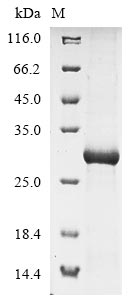Purity
Greater than 85% as determined by SDS-PAGE.
Species
Mus musculus (Mouse)
Expression Region
52-294aa
Target Protein Sequence
LLSSASSKLRVLLSHQDLLRTNASEQKMTLSSLKDDIGACRNCCSVTKAQLQTTLAEFKDIQAKLMEQESILKELQERVTQDLAKASRDRENIRSELFQALEAVKRQNSSCEQCPPSWLPFQGSCYYFSETQATWDTAQSYCGGQGAHLVIVRGLNEQGFLSQHTRGRGYWLGLRAVRHLNKIQGYRWVDGASLNFSHWNSGEPNDSRGHEDCIMMLHSGLWNDAPCTNERDGWICEKRSSCY
Note: The complete sequence including tag
sequence, target protein sequence and linker sequence could be provided upon request.
Tag Info
N-terminal 6xHis-tagged
Form
Liquid or Lyophilized powder
Note: We will preferentially ship the format that
we have in stock, however, if you have any special requirement for the format, please remark your
requirement when placing the order, we will prepare according to your demand.
Buffer
If the delivery form is liquid, the default storage buffer is Tris/PBS-based buffer, 5%-50% glycerol.
If the delivery form is lyophilized powder, the buffer before lyophilization is Tris/PBS-based buffer, 6% Trehalose, pH 8.0.
Reconstitution
We recommend that this vial be briefly centrifuged prior to opening to bring the contents to the bottom. Please reconstitute protein in deionized sterile water to a concentration of 0.1-1.0 mg/mL.We recommend to add 5-50% of glycerol (final concentration) and aliquot for long-term storage at -20°C/-80°C. Our default final concentration of glycerol is 50%. Customers could use it as reference.
Storage Condition
Store at -20°C/-80°C upon receipt, aliquoting is necessary for mutiple use. Avoid repeated freeze-thaw
cycles.
Shelf Life
The shelf life is related to many factors, storage state, buffer ingredients, storage temperature
and the stability of the protein itself.
Generally, the shelf life of liquid form is 6 months at -20°C/-80°C. The shelf life of lyophilized
form is 12 months at -20°C/-80°C.
Lead Time
3-7 business days
Notes
Repeated freezing and thawing is not recommended. Store working aliquots at 4°C for up to one week.
Datasheet & COA
Please contact us to get it.
Description
The region for expressing recombinant Mouse Clec4g contains amino acids 52-294. The theoretical molecular weight of the Clec4g protein is 31.1 kDa. This Clec4g recombinant protein is manufactured in e.coli. The Clec4g gene fragment has been modified by fusing the N-terminal 6xHis tag, providing convenience in detecting and purifying the recombinant Clec4g protein during the following stages.
The mouse C-type lectin domain family 4 member G (Clec4g) is a transmembrane protein that belongs to the C-type lectin superfamily. It is predominantly expressed in immune cells, such as macrophages and dendritic cells. Clec4g plays a role in the recognition of pathogen-associated molecular patterns (PAMPs) and endogenous ligands. Through its carbohydrate recognition domain (CRD), Clec4g can interact with various glycan structures, contributing to innate immune responses. The activation of Clec4g is associated with the induction of pro-inflammatory cytokines and modulation of immune cell functions. Studying Clec4g aids in understanding innate immunity and the molecular mechanisms involved in pathogen recognition, providing potential targets for therapeutic interventions.






